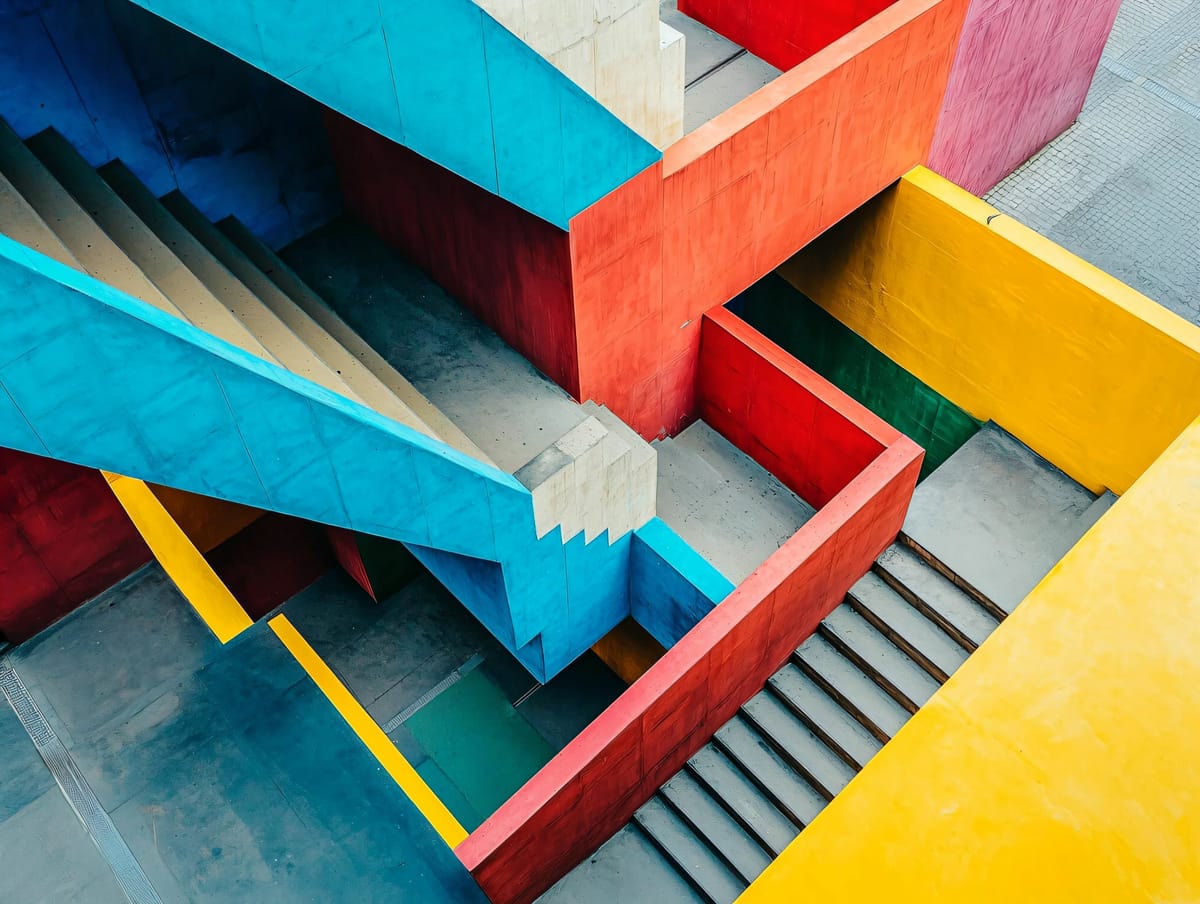Enhancing Spatial Memory: The Impact of Color and Geometry in Architectural Design
How do color and geometry shape what we remember in space? This article explores how vivid visual design—from bold hues to distinct forms—enhances navigation, memory, and user experience in architecture, backed by research in psychology and neuroscience.

The ability to recall and navigate through spatial environments is fundamental to human experience within architectural spaces. An increasing body of research explores how specific design elements can influence cognitive functions, particularly memory and navigation. This report focuses on the impact of color and geometry as critical architectural design elements in enhancing spatial memory. Drawing upon insights from cognitive psychology, neuroscience, and architectural design principles, this interdisciplinary analysis examines how visual elements can improve wayfinding and spatial cognition across various architectural contexts.
1. Introduction: Theoretical Frameworks
The relationship between visual cues and spatial memory is underpinned by several key theoretical frameworks. The Dual Coding Theory posits that information is processed and stored in both visual and verbal systems (Paivio, 1971). Vivid architectural features, such as distinctive colors and geometries, can enhance memory by engaging the visual system, creating strong mental images that are more easily recalled.
Complementing this, the Cognitive Map Theory proposes that individuals form internal representations, or mental maps, of their surroundings to navigate and remember locations (Tolman, 1948; O'Keefe & Nadel, 1978). Distinctive visual elements within a space can contribute to clearer and more detailed cognitive maps, thereby improving wayfinding and the recall of spatial information.
Furthermore, Environmental Psychology examines how the features of an environment, including its visual characteristics, influence cognitive and emotional responses (Gifford, 2007). Color and geometry, as prominent environmental features in architecture, play a significant role in affecting perception, memory, and the ease with which individuals can navigate and interact with a space.
2. The Role of Color in Spatial Memory
Color plays a multifaceted role in influencing spatial memory and navigation. Vivid colors act as potent visual anchors, significantly improving the memorability of architectural features (Dalke et al., 2006). The distinctiveness of bright and contrasting colors allows them to capture attention more effectively than neutral tones, facilitating the brain's encoding of spatial information.
Research in cognitive psychology indicates that attention and arousal levels during memory encoding are influenced by color, with certain colors like red and yellow being particularly attention-grabbing and capable of enhancing memory for specific details (Kwallek et al., 1996; Dzulkifli & Mustafar, 2013). Moreover, different colors can elicit a range of emotional responses, which can indirectly impact memory processes. For instance, calming colors such as blue and green may foster a state of focus conducive to long-term retention (Elliot & Maier, 2014).
The principles of color harmony and temperature are also relevant, as they contribute to the creation of balanced and visually pleasing spaces that can enhance the overall experience of navigation (Mahnke, 1996). In complex architectural environments, color-coding serves as an effective wayfinding tool, providing non-linguistic cues that can guide users (Carpman & Grant, 2016).
3. Geometric Elements and Spatial Cognition
Geometry, characterized by the unique shapes and forms within architectural spaces, also significantly impacts spatial cognition and wayfinding. Distinctive and complex geometries provide salient visual cues that enhance spatial cognition and memory (Evans et al., 1980). Environmental distinctiveness, including the presence of unique geometric forms, has been shown to aid in spatial navigation (Lynch, 1960).
Several architectural case studies illustrate the profound impact of striking geometric forms on a building's memorability. The Seattle Central Library, for example, is recognized for its striking geometric form, while the Guggenheim Museum Bilbao features complex, curved forms that contribute to its iconic and memorable nature. The Eden Project's massive biomes, shaped like geodesic domes, create a visually striking and easily recognizable structure.
Neuroscience research indicates that the brain possesses specialized neural pathways, notably the "where" pathway, for processing the spatial properties of objects and scenes (Ungerleider & Mishkin, 1982). This pathway is crucial for the formation of cognitive maps, highlighting the fundamental role of geometry in how we perceive and navigate our surroundings.
4. Experimental Evidence: Color, Geometry, and Memory Enhancement
A research study specifically investigated the impact of vivid colors and unique geometric shapes on spatial memory. The methodology involved exposing undergraduate architecture students to architectural space designs focused on either vivid colors or unique geometries. Participants were subsequently asked to recall spatial features.
The results indicated a significant enhancement of spatial memory through vividness. Participants demonstrated better recall of features from vividly colored designs compared to those with neutral color schemes (Ware, 2008). Similarly, spaces incorporating unique and varied geometric shapes were remembered more effectively than those with simple shapes (Hölscher et al., 2006).
Furthermore, the study found that vivid designs, whether focused on color or geometry, were associated with faster recall times, suggesting an improvement in memory retrieval speed. Individual differences in visual imagery ability also played a role, with participants who had higher visual imagery skills exhibiting better memory for architectural features (Meilinger & Knauff, 2008). Minimal gender differences were observed, suggesting that the benefits of vivid design on spatial memory are consistent across genders.
These experimental findings provide strong support for the idea that vividness, achieved through both color and geometry, acts as a powerful visual cue that enhances spatial memory. The direct comparison between vividly designed spaces and those with neutral or simple features, along with the measured improvements in recall accuracy and speed, empirically validates the significant role of these design elements in spatial cognition. The influence of individual visual imagery capabilities further suggests that while vivid design is generally beneficial, its impact can be modulated by inherent cognitive differences.
Table 1: Recall Performance for Color and Geometry-Focused Designs
| Metric | Color-Focused Designs (Vivid) | Color-Focused Designs (Neutral) | Geometry-Focused Designs (Unique) | Geometry-Focused Designs (Simple) |
|---|---|---|---|---|
| Average Recall Accuracy | Higher | Lower | Higher | Lower |
| Average Recall Time (Trial 1) | Faster | Slower | Faster | Slower |
| Average Recall Time (Trial 3) | Faster | Slower | Faster | Slower |
5. Architectural Case Studies
Several architectural projects serve as compelling case studies, illustrating the effective use of color and geometry to enhance spatial memory and wayfinding:
- Seattle Central Library (designed by Rem Koolhaas): Renowned for its striking geometric form and innovative use of space, demonstrating how distinctive geometry can contribute to a building's memorability (Mattern, 2007).
- Guggenheim Museum Bilbao (Frank Gehry): With its complex, curved forms clad in titanium, this building stands as an iconic example of how unique and complex geometry can create a highly memorable structure (Van Bruggen, 1997).
- Eden Project (Cornwall, UK): Featuring massive biomes shaped like geodesic domes, this project showcases how distinct geometric shapes can make a building easily recognizable and memorable (Smit, 2001).
- Centre Pompidou (Paris, designed by Renzo Piano and Richard Rogers): Exemplifies the impact of vibrant colors and exposed structural elements in creating a memorable piece of high-tech architecture (Silver & McLean, 2013).
- National Stadium in Beijing ("Bird's Nest"): Utilizes a distinctive lattice-like design and bright colors for lighting, further highlighting the role of unique geometry and color in enhancing a building's memorability (Ren, 2008).
These diverse examples demonstrate that the strategic application of color and geometry is not confined to a particular architectural style but can be effectively employed across various building types to improve spatial memory and user experience.
6. Applications for Specialized Environments
The principles of color and geometry have significant implications for the design of spaces intended for specific needs:
Healthcare Environments
The incorporation of vivid colors and unique geometries can improve wayfinding within complex hospital layouts, making it easier for patients and visitors to navigate (Devlin & Arneill, 2003). Additionally, the use of calming colors, such as soft blues and greens, can contribute to patient well-being by reducing stress and anxiety (Ulrich et al., 2008).
Educational Settings
Color can be employed to enhance focus and memory in learning environments. Stimulating colors may promote engagement, while calming tones can aid concentration (Barrett et al., 2015). The role of geometry in creating engaging and stimulating educational spaces also warrants consideration.
Dementia Care
The use of color contrast and clear visual cues is crucial for aiding wayfinding and reducing disorientation in individuals with dementia (Marquardt, 2011). Familiar geometric patterns and sensory design principles can also contribute to creating a sense of safety and familiarity (Zeisel et al., 2003).
Children's Spaces
Color can be used to create stimulating and memorable environments that support cognitive development and wayfinding abilities in children (Read, 2003). The application of color and geometry in these diverse contexts underscores the importance of tailoring design strategies to the specific cognitive and emotional needs of the intended users.
7. Wayfinding Systems and Visual Elements
Color and geometry play a vital role in creating effective wayfinding systems within the built environment. Legibility, the ease with which a space can be understood and navigated, is a critical aspect of architectural design (Passini, 1984). Distinctive colors and geometric landmarks can serve as key reference points, enabling users to orient themselves and remember routes.
The strategic use of color-coded zones and pathways can effectively guide individuals through complex layouts, providing intuitive cues for navigation (Carpman & Grant, 2016). Furthermore, consistent geometric patterns throughout a building can create a sense of order and predictability, making it easier for users to form a mental map and find their way.
The integration of color and geometry into wayfinding strategies provides non-verbal cues that can be particularly beneficial in diverse or high-traffic environments. While these visual elements are crucial, the overall effectiveness of wayfinding also relies on a logical spatial organization and may be further enhanced by supplementary aids such as clear signage and digital wayfinding tools (Raubal & Egenhofer, 1998).
8. Challenges and Considerations
While the strategic use of vivid colors and complex geometries can enhance spatial memory, it is important to consider potential challenges such as cognitive load and sensory overstimulation. Cognitive load refers to the amount of mental effort required to process information (Sweller, 1988). Overly complex designs, characterized by excessive geometric variation or an abundance of vivid colors, can potentially overwhelm users, particularly those with cognitive impairments or individuals experiencing stress.
Similarly, excessively vivid colors or patterns can lead to sensory overstimulation, especially in environments designed for the elderly or individuals with sensory sensitivities (Mostafa, 2008). Therefore, a balance and moderation in the application of these design elements are crucial.
The optimal level of vividness and geometric complexity is likely to vary depending on the specific user group and the intended function of the architectural space. Design decisions should be informed by a thorough understanding of the target users' cognitive abilities and sensory thresholds to avoid creating environments that are confusing or overwhelming (Arthur & Passini, 1992).
9. Neuroscientific Perspectives
Neuroscience research provides valuable insights into the brain's mechanisms for processing visual and spatial information, which are fundamental to understanding the impact of color and geometry on spatial memory and navigation. The visual cortex contains two primary processing pathways: the ventral stream, often referred to as the "what" pathway, which is primarily involved in object recognition, and the dorsal stream, or "where" pathway, which is crucial for processing spatial information (Ungerleider & Mishkin, 1982).
Color perception is largely processed within the ventral stream, while the dorsal stream handles spatial relationships and the guidance of movement. The hippocampus, a key brain region, plays a critical role in spatial memory, the formation of cognitive maps, and the processing of visual cues necessary for navigation (O'Keefe & Nadel, 1978).
Other brain regions, including the parietal cortex, retrosplenial cortex, and entorhinal cortex, are also integral to spatial processing and navigation, facilitating the integration of sensory information and the maintenance of spatial awareness (Ekstrom et al., 2014). This neuroscientific perspective underscores the biological basis for how visual elements like color and geometry influence our ability to remember and navigate through architectural spaces.
10. Emerging Trends and Technologies
The field of spatial memory and wayfinding is continually evolving, with emerging trends and technologies offering new possibilities for research and design:
- Virtual Reality (VR): VR has become a valuable tool for studying wayfinding behavior in controlled environments and for evaluating the effectiveness of different design interventions (Kalantari & Neo, 2020).
- Augmented Reality (AR) and Digital Wayfinding Tools: These technologies hold significant potential for enhancing navigation in complex architectural spaces by providing users with real-time guidance and information (Afrooz et al., 2019).
- Neuroarchitecture: This interdisciplinary field represents a growing effort to apply findings from neuroscience to the design of built environments, aiming to create spaces that are more attuned to how our brains function and how we experience the world (Eberhard, 2009).
These emerging technologies and interdisciplinary approaches are contributing to a deeper understanding of spatial cognition and paving the way for more evidence-based and human-centered architectural design practices.
11. Design Guidelines and Best Practices
Drawing upon the research findings and insights discussed, several evidence-based design guidelines and best practices can be formulated for architects and designers:
- Strategic Use of Vivid Colors: Intentionally incorporate vivid colors to highlight key areas or landmarks within a building, making them more memorable (Dalke et al., 2006).
- Distinctive Geometric Elements: Utilize unique and distinctive geometric shapes to enhance memorability and provide strong visual cues that aid in navigation (Carlson et al., 2010).
- Color-Coding for Complex Environments: In complex environments such as hospitals and educational institutions, implement color-coding strategies to improve wayfinding by creating intuitive associations between colors and specific zones or pathways (Carpman & Grant, 2016).
- High Color Contrast: Ensure high color contrast for visibility and accessibility, particularly for signage and in spaces designed for the elderly or individuals with visual impairments (Zijlstra et al., 2016).
- Avoid Excessive Complexity: Avoid overly complex geometries or excessively vivid colors, as these can lead to cognitive overload or sensory overstimulation (Arthur & Passini, 1992).
- Cultural Considerations: Consider the psychological and cultural associations of colors, as these can vary depending on the context and user group (Elliot & Maier, 2014).
- Consistency: Maintain consistency in the use of color and geometry throughout a building to create a coherent and easily navigable environment (Lynch, 1960).
- Biophilic Elements: Where appropriate, incorporate natural materials and biophilic design principles to enhance user well-being and spatial experience (Browning et al., 2014).
- Individual Differences: Consider individual differences in spatial abilities and sensory sensitivities when making design choices to ensure that the built environment is inclusive and accessible to all users (Meilinger & Knauff, 2008).
The successful application of these guidelines requires a thoughtful and user-centered approach, balancing the desire to enhance memory with the need to create spaces that are comfortable, intuitive, and easy to navigate.
12. Conclusion
Color and geometry in architectural design exert a significant influence on spatial memory and wayfinding. Thoughtful and evidence-based design that strategically incorporates vivid colors and distinctive geometric shapes can enhance user experience, improve navigation, and create more memorable and supportive environments.
By understanding the underlying cognitive mechanisms and considering the potential challenges, architects and designers can leverage these powerful visual elements to create built spaces that are not only aesthetically pleasing but also optimally aligned with human cognitive capabilities. The continued integration of insights from cognitive psychology and neuroscience into architectural design practices holds great promise for creating increasingly effective and human-centered environments.
References
Afrooz, A., White, D., & Parolin, B. (2019). Effects of active and passive exploration of the built environment on memory during wayfinding. Applied Geography, 101, 68-74. https://doi.org/10.1016/j.apgeog.2018.10.009
Arthur, P., & Passini, R. (1992). Wayfinding: People, signs, and architecture. McGraw-Hill.
Barrett, P., Davies, F., Zhang, Y., & Barrett, L. (2015). The impact of classroom design on pupils' learning: Final results of a holistic, multi-level analysis. Building and Environment, 89, 118-133. https://doi.org/10.1016/j.buildenv.2015.02.013
Browning, W.D., Ryan, C.O., & Clancy, J.O. (2014). 14 patterns of biophilic design. Terrapin Bright Green LLC.
Carlson, L. A., Hölscher, C., Shipley, T. F., & Dalton, R. C. (2010). Getting lost in buildings. Current Directions in Psychological Science, 19(5), 284-289. https://doi.org/10.1177/0963721410383243
Carpman, J. R., & Grant, M. A. (2016). Design that cares: Planning health facilities for patients and visitors (3rd ed.). Jossey-Bass.
Dalke, H., Little, J., Niemann, E., Camgoz, N., Steadman, G., Hill, S., & Stott, L. (2006). Colour and lighting in hospital design. Optics & Laser Technology, 38(4-6), 343-365. https://doi.org/10.1016/j.optlastec.2005.06.040
Devlin, A. S., & Arneill, A. B. (2003). Health care environments and patient outcomes: A review of the literature. Environment and Behavior, 35(5), 665-694. https://doi.org/10.1177/0013916503255102
Dzulkifli, M. A., & Mustafar, M. F. (2013). The influence of colour on memory performance: A review. Malaysian Journal of Medical Sciences, 20(2), 3-9.
Eberhard, J. P. (2009). Brain landscape: The coexistence of neuroscience and architecture. Oxford University Press.
Ekstrom, A. D., Arnold, A. E., & Iaria, G. (2014). A critical review of the allocentric spatial representation and its neural underpinnings: Toward a network-based perspective. Frontiers in Human Neuroscience, 8, 803. https://doi.org/10.3389/fnhum.2014.00803
Elliot, A. J., & Maier, M. A. (2014). Color psychology: Effects of perceiving color on psychological functioning in humans. Annual Review of Psychology, 65, 95-120. https://doi.org/10.1146/annurev-psych-010213-115035
Evans, G. W., Smith, C., & Pezdek, K. (1980). Cognitive maps and urban form. Journal of the American Planning Association, 46(2), 232-244. https://doi.org/10.1080/01944368208976541
Gifford, R. (2007). Environmental psychology: Principles and practice (4th ed.). Optimal Books.
Hölscher, C., Meilinger, T., Vrachliotis, G., Brösamle, M., & Knauff, M. (2006). Up the down staircase: Wayfinding strategies in multi-level buildings. Journal of Environmental Psychology, 26(4), 284-299. https://doi.org/10.1016/j.jenvp.2006.09.002
Kalantari, S., & Neo, J. R. J. (2020). Virtual environments for design research: Lessons learned from use of fully immersive virtual reality in interior design research. Journal of Interior Design, 45(3), 27-42. https://doi.org/10.1111/joid.12171
Kwallek, N., Lewis, C. M., & Robbins, A. S. (1996). Effects of office interior color on workers' mood and productivity. Perceptual and Motor Skills, 83(1), 235-241. https://doi.org/10.2466/pms.1996.83.1.235
Lynch, K. (1960). The image of the city. MIT Press.
Mahnke, F. H. (1996). Color, environment, and human response: An interdisciplinary understanding of color and its use as a beneficial element in the design of the architectural environment. John Wiley & Sons.
Marquardt, G. (2011). Wayfinding for people with dementia: A review of the role of architectural design. HERD: Health Environments Research & Design Journal, 4(2), 75-90. https://doi.org/10.1177/193758671100400207
Mattern, S. (2007). The new downtown library: Designing with communities. University of Minnesota Press.
Meilinger, T., & Knauff, M. (2008). Ask for directions or use a map: A field experiment on spatial orientation and wayfinding in an urban environment. Journal of Spatial Science, 53(2), 13-23. https://doi.org/10.1080/14498596.2008.9635147
Mostafa, M. (2008). An architecture for autism: Concepts of design intervention for the autistic user. International Journal of Architectural Research, 2(1), 189-211.
O'Keefe, J., & Nadel, L. (1978). The hippocampus as a cognitive map. Oxford University Press.
Paivio, A. (1971). Imagery and verbal processes. Holt, Rinehart and Winston.
Passini, R. (1984). Wayfinding in architecture. Van Nostrand Reinhold.
Raubal, M., & Egenhofer, M. J. (1998). Comparing the complexity of wayfinding tasks in built environments. Environment and Planning B: Planning and Design, 25(6), 895-913. https://doi.org/10.1068/b250895
Read, M. A. (2003). Use of color in child care environments: Application of color for wayfinding and space definition in Alabama child care environments. Early Childhood Education Journal, 30(4), 233-239. https://doi.org/10.1023/A:1023387607942
Ren, H. (2008). The "Bird's Nest": What makes the stadium special? Sports Technology, 1(1), 30-35. https://doi.org/10.1080/19346182.2008.9648444
Silver, N., & McLean, W. (2013). Centre Pompidou. Phaidon Press.
Smit, T. (2001). Eden. Transworld Publishers.
Sweller, J. (1988). Cognitive load during problem solving: Effects on learning. Cognitive Science, 12(2), 257-285. https://doi.org/10.1207/s15516709cog1202_4
Tolman, E. C. (1948). Cognitive maps in rats and men. Psychological Review, 55(4), 189-208. https://doi.org/10.1037/h0061626
Ulrich, R. S., Zimring, C., Zhu, X., DuBose, J., Seo, H. B., Choi, Y. S., Quan, X., & Joseph, A. (2008). A review of the research literature on evidence-based healthcare design. HERD: Health Environments Research & Design Journal, 1(3), 61-125. https://doi.org/10.1177/193758670800100306
Ungerleider, L. G., & Mishkin, M. (1982). Two cortical visual systems. In D. J. Ingle, M. A. Goodale, & R. J. W. Mansfield (Eds.), Analysis of visual behavior (pp. 549-586). MIT Press.
Van Bruggen, C. (1997). Frank O. Gehry: Guggenheim Museum Bilbao. Guggenheim Museum Publications.
Ware, C. (2008). Visual thinking for design. Morgan Kaufmann.
Zeisel, J., Silverstein, N. M., Hyde, J., Levkoff, S., Lawton, M. P., & Holmes, W. (2003). Environmental correlates to behavioral health outcomes in Alzheimer's special care units. The Gerontologist, 43(5), 697-711. https://doi.org/10.1093/geront/43.5.697
Zijlstra, E., Hagedoorn, M., Krijnen, W. P., van der Schans, C. P., & Mobach, M. P. (2016). Route complexity and simulated physical ageing negatively influence wayfinding. Applied Ergonomics, 56, 62-67. https://doi.org/10.1016/j.apergo.2016.03.009


